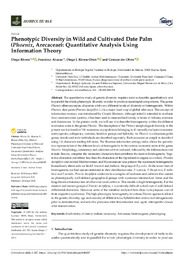Please use this identifier to cite or link to this item:
https://hdl.handle.net/11000/38317Full metadata record
| DC Field | Value | Language |
|---|---|---|
| dc.contributor.author | Rivera, Diego | - |
| dc.contributor.author | Alcaraz, Francisco | - |
| dc.contributor.author | Rivera-Obón, Diego J. | - |
| dc.contributor.author | Obón, Concepción | - |
| dc.contributor.other | Departamentos de la UMH::Biología Aplicada | es_ES |
| dc.date.accessioned | 2025-11-20T07:39:17Z | - |
| dc.date.available | 2025-11-20T07:39:17Z | - |
| dc.date.created | 2022-03 | - |
| dc.identifier.citation | Horticulturae 2022, 8, 287 | es_ES |
| dc.identifier.issn | 2311-7524 | - |
| dc.identifier.uri | https://hdl.handle.net/11000/38317 | - |
| dc.description.abstract | The quantitative study of genetic diversity requires tools to describe quantitatively and in parallel the whole phenotypic diversity in order to produce meaningful comparisons. The genus Phoenix offers examples of species with very different levels of diversity or heterogeneity. Within Phoenix, date palm (Phoenix dactylifera L.) is a major food crop of global relevance. The concept of information entropy was introduced by Claude Shannon; although initially intended to evaluate data communication systems, it has been used to measure biodiversity in terms of richness, evenness and dominance. In the present work, we will use it to describe heterogeneity within the different taxonomic units in the genus Phoenix. The description of the Phoenix morphological diversity in the present work is based on 596 accessions or populations belonging to 43 mutually exclusive taxonomic units (species, subspecies, varieties, landrace groups and hybrids). As Phoenix is a dioecious palm genus, female and male individuals are described separately. Each accession or sample is described using 116 characters totaling 449 states. The Shannon information entropy index allows the quantitative representation of the different levels of heterogeneity in the various taxonomic units of the genus Phoenix. Morphology, consistency and coloration of fruit and seed, followed by the inflorescences and female flowers, comprise the taxonomic characters that contribute the most to heterogeneity. Vegetative characters contribute less than the characters of the reproductive organs as a whole. Phoenix dactylifera and related Mediterranean and Macaronesian taxa present the maximum heterogeneity. Immediately afterwards we find P. loureiroi and, behind, the group of P. pusilla. At the lower limit of heterogeneity, we find species restricted in their distribution area: P. rupicola, P. theophrasti, P. roebelenii and P. acaulis. Phoenix dactylifera conforms to a complex of landraces and cultivars that coexist as phenotypically well-defined geographical groups with numerous intermediate forms and the long-distance translocation of otherwise local cultivars. This results in high heterogeneity. For the western and eastern groups of Phoenix dactylifera, it is extremely difficult to find a set of well-defined differential characters. However, some of the variables analyzed here allow us to propose a set of their respective syndromes. The high phenotypic heterogeneity in various Phoenix species is related to the genetic diversity, age and ancestry of different taxa, hybridization events and introgressions prior to domestication, and selective pressures after domestication and, again, interspecific crosses after domestication. | es_ES |
| dc.format | application/pdf | es_ES |
| dc.format.extent | 26 | es_ES |
| dc.language.iso | eng | es_ES |
| dc.publisher | MDPI | es_ES |
| dc.rights | info:eu-repo/semantics/openAccess | es_ES |
| dc.rights.uri | http://creativecommons.org/licenses/by-nc-nd/4.0/ | * |
| dc.subject | biodiversity | es_ES |
| dc.subject | diversity indices | es_ES |
| dc.subject | taxonomy | es_ES |
| dc.subject | Arecaceae | es_ES |
| dc.subject | heterozygosis | es_ES |
| dc.subject | phenotyping | es_ES |
| dc.title | Phenotypic Diversity in Wild and Cultivated Date Palm (Phoenix, Arecaceae): Quantitative Analysis Using Information Theory | es_ES |
| dc.type | info:eu-repo/semantics/article | es_ES |
| dc.relation.publisherversion | https://doi.org/10.3390/horticulturae8040287 | es_ES |

View/Open:
Palmera Bayes 2022 horticulturae-08-00287r.pdf
1,73 MB
Adobe PDF
Share:
.png)
